

The evolving IT landscape. Managing big data privacy concerns: Tactics for proactive enterprises. This article can also be found in the Premium Editorial Download "Information Security magazine: Outsourcing security services.

" Download it now to read this article plus other related content. Big Data : un nouvel air souffle sur la Business Intelligence. Selon une récente étude d’IDC, le Big Data reste encore un terme flou pour 46% des responsables IT.

Et pourtant, « ce mot qui fait partie des mots les plus confus de cette décennie » comme le dirait Philippe Nieuwbourg, est en train d’offrir le renouveau tant attendu par les professionnels du monde du décisionnel. En fait, les 3 V (volume, variété et vélocité) du Big Data vont (enfin !) Pouvoir donner un nouveau souffle à la Business Intelligence. Ce n’est plus trahir un secret que d’affirmer que la Business Intelligence, dite traditionnelle, atteint ses limites : • Un datawarehouse de quelques téraoctets est très compliqué à maintenir et à faire évoluer. L’éléphant jaune ouvre de nouvelles perspectives à la Business Intelligence Le renouveau des architectures décisionnelles.
Q&A: Sanjay Mirchandani, CIO, EMC. If data sits on a desk somewhere and is not being used, it’s an opportunity wasted Sanjay Mirchandani believes IT has to take the lead in adding value to the business in the form of big data “addictive analytics.”
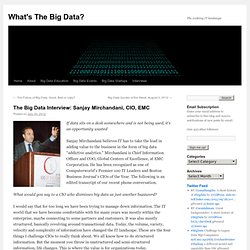
Mirchandani is Chief Information Officer and COO, Global Centers of Excellence, at EMC Corporation. He has been recognized as one of Computerworld’s Premier 100 IT Leaders and Boston Business Journal’s CIOs of the Year. Q&A: The Biggest Big Data Trend. Q&A: Big Data through the Looking Glass. Gartner's Hype Cycle 2009 vs 2012. Global analyst Gartner issues various annual hype cycles, including the famous one in Emerging Technologies.
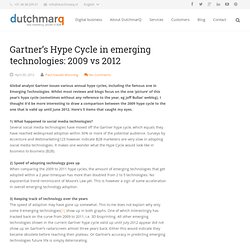
Whilst most reviews and blogs focus on the one ‘picture’ of this year’s hype cycle (sometimes without any reference to the year, eg Jeff Bullas’ weblog), I thought it’d be more interesting to draw a comparison between the 2009 hype cycle to the one that is valid up until June 2012. Here’s 5 items that caught my eyes. 1) What happened to social media technologies? Several social media technologies have moved off the Gartner hype cycle, which equals they have reached widespread adoption within 30% or more of the potential audience.
Surveys by Accenture and Webmarketing123 however indicate B2B marketers are very slow in adopting social media technologies. 2) Speed of adopting technology goes up When comparing the 2009 to 2011 hype cycles, the amount of emerging technologies that get adopted within a 2 year-timespan has more than doubled from 2 to 5 technologies. Gartner: Mobility, Big Data on the Rise; Cloud Not so Much. IT Trends | Feature Gartner: Mobility, Big Data on the Rise; Cloud Not so Much Mobile devices and data-driven decision-making tip the scales in Gartner's midyear re-evaluation of top IT trends.

By Dian Schaffhauser06/21/12. Gartner on Big Data. Gartner on Big Data In its just-published Hype Cycle for Cloud Computing 2012, Gartner predicts that “Big Data will deliver transformational benefits to enterprises within 2 to 5 years, and by 2015 will enable enterprises adopting this technology to outperform competitors by 20% in every available financial metric.”
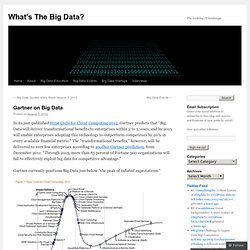
The “transformational benefits,” however, will be delivered to very few enterprises according to another Gartner prediction, from December 2011: “Through 2015, more than 85 percent of Fortune 500 organizations will fail to effectively exploit big data for competitive advantage.” CIO Agenda: Big Data Ecosystem. IN TERMS of ‘forces’ affecting the CIO Agenda, Information Strategy and Enterprise Architecture, Big Data is increasingly important.

This is due to explosive growth in number of data source types: applications, digital media, mobiles, users, customers, unstructured data sets, sensors, emails, blogs etc. Data is complex and in mixed formats (text, video, audio), on-demand infrastructure scalability (including massively scalable storage) is needed to deliver Big Data capabilities, as are robust analytics and visualisation tools and techniques for distributed, parallel systems. Increasing bandwidth availability has also led to exponential data growth rates and capabilities e.g. social networks, video and microblogging. What Does Big Data Mean for the Future of Self-service BI. Big Data Refinery Fuels Next-Generation Data Architecture. Since joining Hortonworks at the beginning of the year, a question I’ve heard over and over again is “What is Apache Hadoop and what is it used for?”
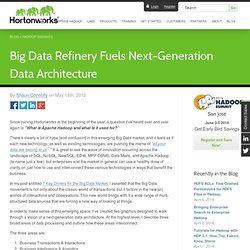
There’s clearly a lot of hype [and confusion] in this emerging Big Data market, and it feels as if each new technology, as well as existing technologies, are pushing the meme of “all your data are belong to us”. It is great to see the wave of innovation occurring across the landscape of SQL, NoSQL, NewSQL, EDW, MPP DBMS, Data Marts, and Apache Hadoop (to name just a few), but enterprises and the market in general can use a healthy dose of clarity on just how to use and interconnect these various technologies in ways that benefit the business.
Big Data : Network Design Considerations. What You Will Learn This document examines the role of big data in the enterprise as it relates to network design considerations.
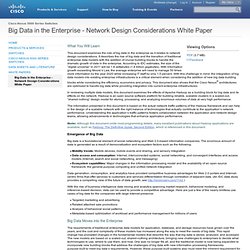
It describes the rise of big data and the transition of traditional enterprise data models with the addition of crucial building blocks to handle the dramatic growth of data in the enterprise. According to IDC estimates, the size of the “digital universe” in 2011 will be 1.8 zettabytes (1.8 trillion gigabytes). With information growth exceeding Moore’s Law, the average enterprise will need to manage 50 times more information by the year 2020 while increasing IT staff by only 1.5 percent. A Very Short History of Big Data. In addition to researching A Very Short History of Data Science, I have also been looking at the history of how data became big.

Here I focus on the history of attempts to quantify the growth rate in the volume of data or what has popularly been known as the “information explosion” (a term first used in 1941, according to the OED). The following are the major milestones in the history of sizing data volumes plus other “firsts” or observations pertaining to the evolution of the idea of “big data.” The Definition of Enterprise Big Data. With David Vellante With the inaugural O'Reilly Media Strata conference, the topic of is coming into sharper focus. When O'Reilly initiates coverage of a topic through an event like Strata, you can be sure the content will be well-thought-out, rich, relevant and visionary in nature. A key theme that emerged from the event was that Big Data is not just about cool technologies and Web 2.0 companies experimenting with gigantic data sets. Rather it's defining new value streams based on leveraging information.
The confluence of enterprise IT, cloud computing and Big Data are combining with mobility and emerging social trends to re-shape the technology industry this decade. The Origins of Hadoop. Doug Cutting of Cloudera joins SiliconAngle’s John Furrier and Wikibon’s Dave Vellante at Hadoop World 2010. Doug brought with him Hadoop, his son’s elephant doll and the inspiration for the Hadoop name, and he talks about the humble beginnings of spreading data on multiple machines. “We weren’t going to get it running on thousand of machines without a lot of work.
It’s a tricky kind of programming to do… I had the name sitting in my pocket from when my son named this thing [yellow elephant]. I thought, ‘That’s a good project name. It’s a short word…and I also liked that there was an obvious mascot. " Pundit, policy wonk and new media trailblazer, Arthur Lindsey III has been talking politics for more than a decade. Why the 3Vs Just Don't Make Sense. Big Data -- Why the 3Vs Just Don't Make Sense The industry seems to have settled on 3 Vs -- volume, variety, and velocity -- to describe the big data problem. What's missing? Let's start with another V: value. The "big" in "big data" is a function of the volume, variety, and velocity of the information that constitutes it. If you read a dozen articles on big data, there's a good chance the 3 Vs -- volume, variety, and velocity -- will be cited in at least half of them. This strikes many industry veterans as wrong-headed because if big data is understood solely on the basis of these trends, it isn't clear that it's at all hype-worthy.
The confluence or collision of the 3V trend lines certainly isn't a new idea: Gartner Inc. analyst Doug Laney first codified this concept -- using the same 3 Vs -- over a decade ago while an analyst with (the now-defunct) MetaGroup. There's a disconnect here, however.